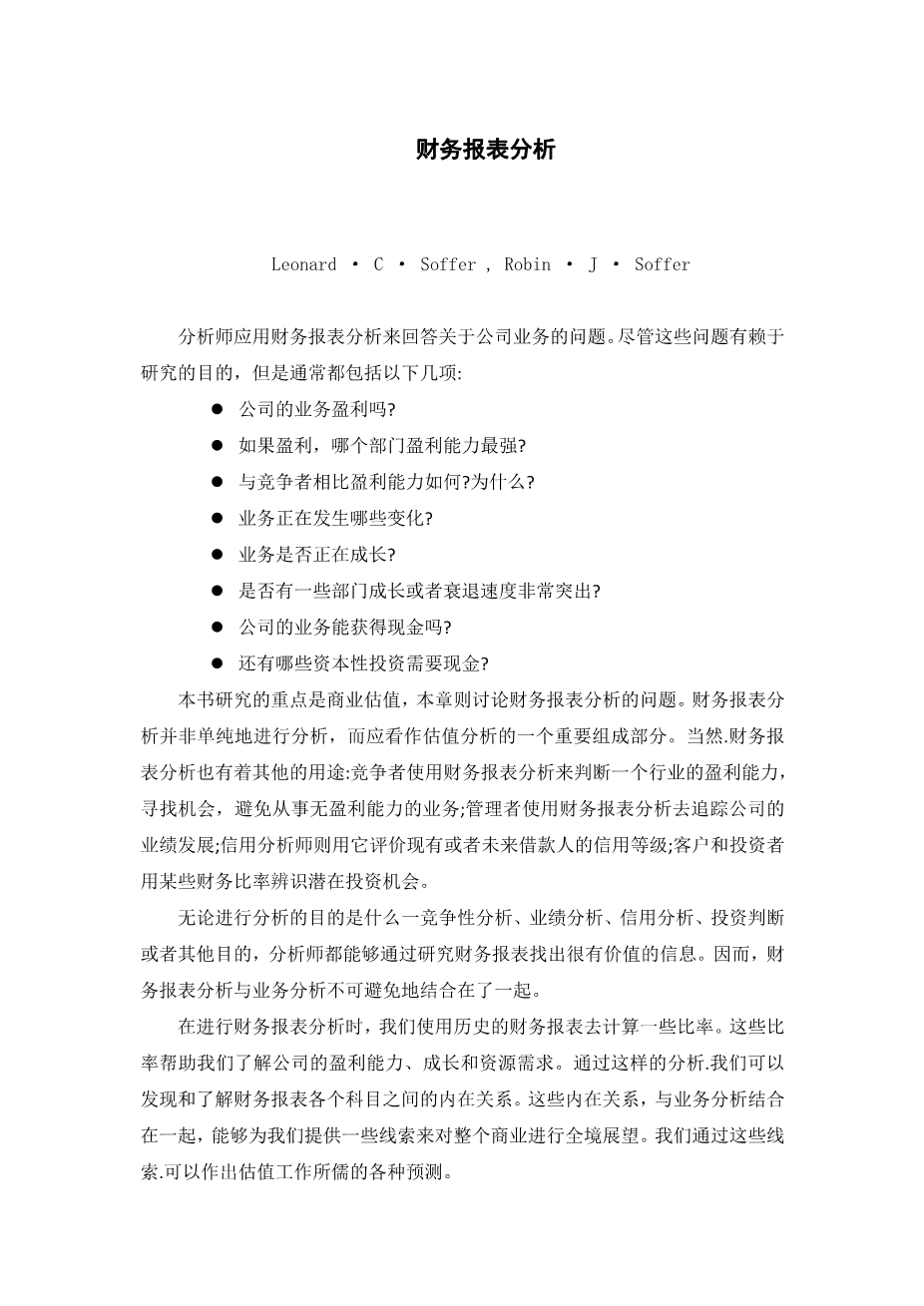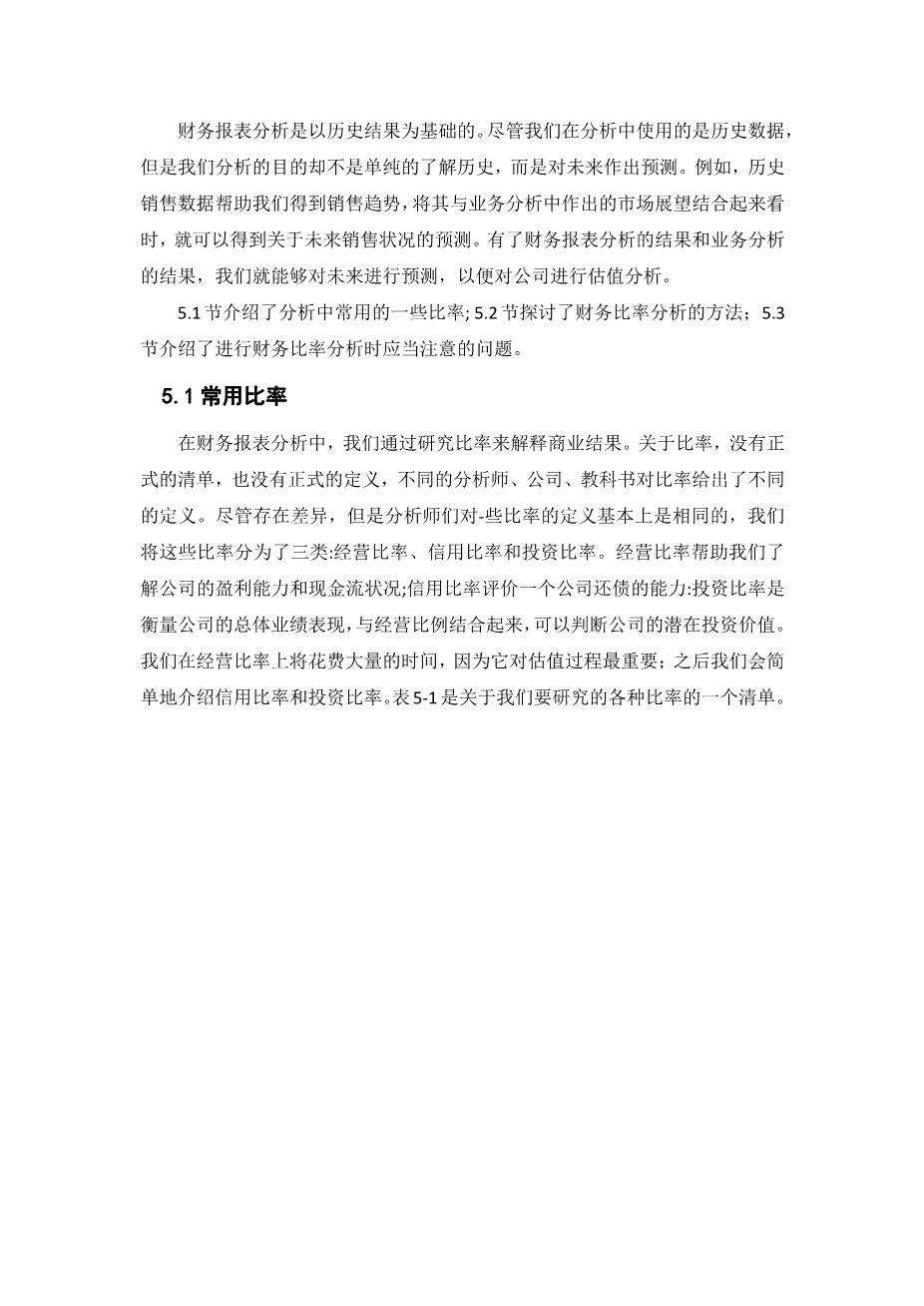Financial Statement Analysis
Leonard · C · Soffer , Robin · J · Soffer
Analysts use financial statement analysis to answer questions about the business. The questions depend on the underlying purpose of their analyses but often include these:
- Is the business profitable?
- If so, which segments are most profitable?
- How does the profitability compare to that of the competition and why?
- What is changing in the business?
- Is the business growing?
- Are certain segments growing or declining more than others?
- Does the business generate cash?
- What are the cash needs for additional capital investments?
The focus of this book is business valuation. Much of our discussion in this chapter deals with using financial statement analysis not for its own sake, but as part of a valuation analysis. However, financial statement analysis is used for other applications as well. Competitors use financial statement analysis to judge the relative profitability of businesses in an industry, identify opportunities, and avoid unprofitable sectors. Managers use financial statement analysis to track their firms performances. Credit analysts evaluate the creditworthiness of current and prospective borrowers, and customers and investors use certain ratios to screen potential investments.
Regardless of the underlying purpose of an analysis-whether it is competitive analysis, performance analysis, credit analysis, investment screening, or some other goal-analysts can gain a wealth of information about a business from studying its financial statements. In this way, financial statement analysis is inextricably linked to business analysis.
In financial statement analysis, we use the information provided in historical financial statements to calculate ratios. These ratios help us learn about such things as the firms profitability, growth, and resource needs. Through this analysis, we detect and understand relationships among various financial statement items. These relationships, along with the information gained in the business analysis, will provide clues about the outlook for the business. We will use these cues to develop the forecasts needed in our valuation work.
Financial statement analysis is based on historical results. Although we use data from the historical financial statements in our analysis, the purpose of financial statement analysis is not only to understand the history but also to use that information to forecast the future. For example, historical sales information helps us understand the business trends. When we combine this historical information with the market outlook derived in the business analysis, we will be able to develop sales forecast assumptions. The results of financial statement and business analyses lead to forecast assumptions that enable us to value the firm.
Section 5.1 presents ratios that analysts commonly study. Section 5.2 discusses the ways in which ratios are analyzed. Section 5.3 covers the cautions analysts must consider when using financial ratios.
5.1 COMMON RATIOS
In financial statement analysis, we study ratios that are helpful in interpreting business results. There is no “official” list of ratios nor “official' definitions of any ratios. Different analysts, firms, and textbooks define ratios differently. Despite these differences, analysts commonly use a number of ratios with fairly consistent definitions. We organize these ratios into three types: operating ratios, credit ratios, and investment ratios. Operating ratios help us understand the profitability and cash flow of the business operations. Credit ratios measure a firms ability to repay obligations. Investment ratios measure a firms total performance and are used, along with the operating ratios, to screen potential investments.
We spend the most time on operating ratios, which are used much more extensively in the valuation process, and briefly discuss common credit ratios and investment ratios. Exhibit 5.2 is an outline of the ratios we will study.
5.1.1 Operating Ratios
Analysts use operating ratios to understand elements of a companys business, such as profitability and capital efficiency. This, in turn, will help forecast earnings and cash flows. Internal managers also track operating ratios to help them understand business performance. If a ratio deviates significantly from its expected level, more detailed analysis may be needed to determine the source of the problem. Ultimately, this may lead to corrective actions, such as the replacement of a manager, an adjustment to pricing or cost reduction measures.
Although we can define a ratio any way we want, ratios are most meaningful when the numerator and denominator are related to each other. Exhibit 5.3 presents some common operating ratios for Starbucks for fiscal 2000. In defining these ratios, we use Starbucks terminology. Different companies use different terms, so you may see definitions that look slightly different as you study other companies. For example, Starbucks
uses the term gross margin to refer to revenues less cost of sales .Other companies, such as Mattel, all this amount gross profit. Some use the term gross margin to refer to the ratio of gross profit to revenues.Starbucks is mostly a cash business, so this ratio (10.4 days) is a low value. The next ratio, days payables outstanding, is calculated in a similar way. It shows that Starbucks takes slightly less than a month to pay its payables, assuming the bulk of the payables relate to cost of sales. Too low a ratio indicates that the company is not using its available trade credit to its benefit. Too high a ratio indicates a problem in making payments. Common credit terms are 30 days, so 24.8 days is a reasonable value.
lt;
剩余内容已隐藏,支付完成后下载完整资料


英语译文共 20 页,剩余内容已隐藏,支付完成后下载完整资料
资料编号:[411973],资料为PDF文档或Word文档,PDF文档可免费转换为Word
|
Operating Ratios |


